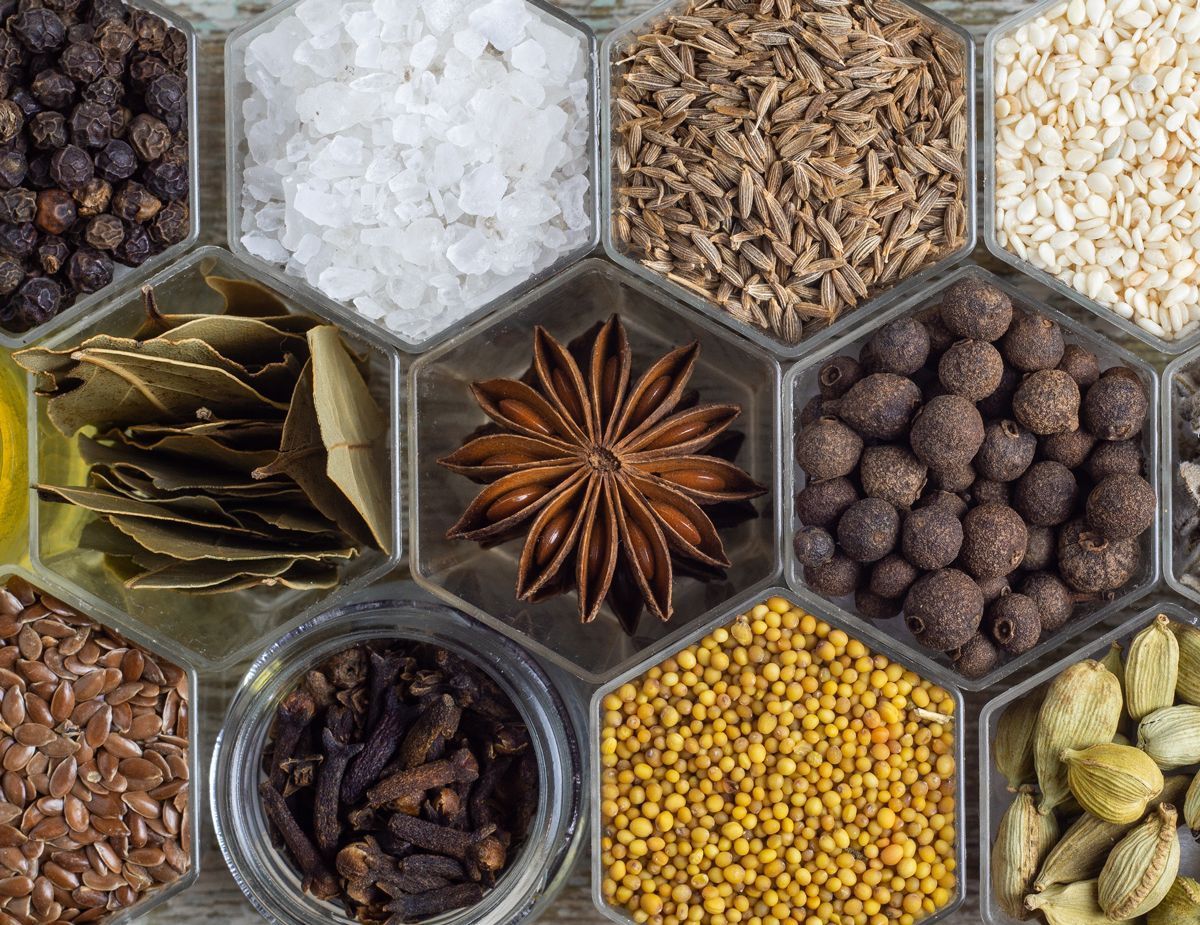Winter soups, stews, and drinks with warm spices are a great way to nourish the body and soul during the colder months. Warming spices not only enhance the taste of food but also offer a range of incredible health benefits. From boosting digestion and metabolism to reducing inflammation, warming spices are renowned for their medicinal properties.
In this article, we explore the benefits of warm spices, how to incorporate them into your daily routine, and tips for choosing high-quality spice options. We also answer frequently asked questions about warm spices and highlight some of our favorite recipes.

Warm Spices Are Good for Your Health
Warm spices not only add delightful flavors to your dishes but also offer numerous health benefits. These aromatic spices possess anti-inflammatory properties that boost immunity and support digestion.
One key role of warm spices is their ability to enhance the immune system. Cinnamon, ginger, and turmeric are packed with antioxidants and antimicrobial compounds that can help strengthen the body’s defense against illnesses. Incorporating these warming spices into your daily diet can contribute to a healthier immune system.
In addition to boosting immunity, warm spices are known to support digestion. Spices like ginger, cardamom, and black pepper have been traditionally used to alleviate digestive issues such as bloating, indigestion, and nausea. These spices stimulate the production of digestive enzymes, aid in nutrient absorption, and promote a healthy gut.
Furthermore, warm spices possess anti-inflammatory properties that can help reduce inflammation in the body. Turmeric, for example, contains curcumin, a powerful compound known for its anti-inflammatory effects. Regular consumption of warm spices can potentially alleviate chronic inflammation, which is linked to various health conditions, including heart disease, diabetes, and arthritis.
Explore our selection of cinnamon, ginger, turmeric, cardamom, and more, and start reaping the health benefits of these warm spices today.
Top Warm Spices for a Healthy Lifestyle
Warm spices are a must-have in your pantry. Not only do they bring warmth and aroma to your favorite recipes, but many of these spices also offer incredible health benefits. Here are some of the top warm spices that are good for your health:
Cinnamon: Known for its sweet and warm taste, cinnamon is a versatile spice that goes well with both sweet and savory dishes. But did you know that cinnamon is also packed with antioxidants and has anti-inflammatory properties? Studies have shown that cinnamon may help regulate blood sugar levels, improve heart health, and boost brain function.
* Try sprinkling cinnamon on your next pot roast dish while cooking for a unique and surprising flavor.
Cloves: With their unique and intense flavor, cloves are a popular spice used in many cuisines worldwide. Besides their culinary purposes, cloves have been used for centuries for their medicinal properties. They are rich in antioxidants and have antibacterial and anti-inflammatory effects. Cloves may help support oral health, improve digestion, and promote bone health.
* Chew on whole cloves as a natural and effective way to freshen your breath.
Ginger: Known for its distinct spicy taste, ginger has long been used in traditional medicine for its many health benefits. Ginger is known to aid digestion, reduce inflammation, and relieve nausea. It contains powerful compounds called gingerols, which have antioxidant and anti-inflammatory properties that may help with joint pain and muscle soreness.
* Infuse your tea with ginger to help you through a winter cold or flu.
Turmeric: This spice is what gives curry its bright yellow color. It contains curcumin, a compound proven to improve blood flow and warm bodily extremities. Some evidence suggests this spice may support healthy liver function.
* A half teaspoon of turmeric is usually enough to liven up a bean dish, rice dish, grains, marinade, and stew.
Nutmeg: With its warm and fragrant flavor, nutmeg is a popular spice in sweet and savory dishes. Besides adding depth to your recipes, nutmeg also offers surprising health benefits. It contains essential oils that have antibacterial properties and can help improve digestion. Nutmeg is also rich in antioxidants, which may help protect against cellular damage.
* Try sprinkling nutmeg in hot cocoa or coffee for an exciting flavor burst.
Incorporating Warm Spices into Your Daily Routine
Spice up your daily routine for improved health and flavor. Here are some delicious recipe ideas from our local partners and Market of Choice Chefs featuring warm spices:
- Oregon Heritage Farms Spiced Apple Muffins are packed with fresh apples and plenty of warming spices, like cinnamon, ginger, and nutmeg.
- Spicy Tofu Hot Pot is a delicious yet easy-to-make hot soup inspired by Korean tofu hot pots full of flavor and healthy warming spices.
- Detox Lemon Ginger Soup with Ginger, Turmeric, Turmeric, chilies & Greens is packed with anti-inflammatory ingredients and a great way to detox after the holidays.
If you’re looking for creative ways to use warm spices in beverages, try these ideas:
- Spiced Chai Latte: Brew a cup of black tea with warm spices like cinnamon, cardamom, ginger, and cloves. Add some milk and sweeten to taste for a delicious homemade spiced chai latte.
- Golden Milk Turmeric Latte: Combine turmeric, ginger, cinnamon, and black pepper with warm milk for a soothing and immune-boosting golden milk turmeric latte.
Proper Care & Storage of Warm Spices
Ensure the quality and freshness of your warm spices by following these tips for storing and preserving them:
- Store in a cool, dark place: Keep your spices away from direct sunlight and heat to maintain flavor and potency.
- Use airtight containers: Transfer your spices to airtight containers to protect them from moisture and air exposure. Find high-quality air-tight storage containers in our Home & Gift Department.
- Check expiration dates: Spices lose their potency over time, so regularly check them and replace any past their prime.
By incorporating warm spices into your daily routine, you can elevate the taste of your meals and enjoy their numerous health benefits. Explore the wide variety of warm spices available at Market of Choice and start spicing up your dishes today!
Choosing High-Quality Warm Spices
When incorporating warm spices into your diet, sourcing high-quality options may be key to enjoying their full benefits. Whether you’re a seasoned chef or a cooking enthusiast, understanding the importance of sourcing can make a significant difference in the flavor and health benefits of your dishes.
One of the most crucial tips for selecting fresh and potent warm spices is to consider their origin. Look for spices sourced from reputable suppliers who prioritize quality and freshness. Market of Choice takes pride in partnering with trusted suppliers who adhere to strict quality standards.
Choosing organic spices ensures they are free from harmful pesticides and chemicals, making them a healthier choice for you and the environment. Market of Choice offers a wide range of organic, warm spices, allowing you to enhance your dishes while supporting sustainable practices.
When shopping for warm spices, pay attention to packaging and storage conditions. Opt for spices packaged in airtight containers to preserve their freshness and potency. Storing spices in a cool, dry place away from direct sunlight will help maintain their flavor and nutritional value.
By choosing high-quality warm spices, you can elevate the taste and health benefits of your culinary creations. Market of Choice is committed to providing customers with the finest selection of warm spices to enhance their cooking experience. Explore our range of organic and sustainably sourced spices in the spice and Bulk Food and discover the difference they can make in your favorite recipes.
Frequently Asked Questions about Warm Spices
Are warm spices safe for everyone, including children?
Warm spices, such as cinnamon, ginger, and nutmeg, are generally safe for everyone, including children. However, it’s always a good idea to consult with a healthcare professional, especially if you have any underlying health conditions or if you are introducing spices to your child’s diet for the first time. While warm spices are generally safe, individual reactions may vary, so it’s important to listen to your body and monitor any potential adverse effects.
Can warm spices help with weight management?
Warm spices have been associated with various health benefits, including potential weight management effects. Some studies suggest that certain warm spices, like cinnamon, may help regulate blood sugar levels, improve insulin sensitivity, and reduce cravings, which can contribute to weight management. However, it’s important to note that warm spices alone are not a magical solution for weight loss. They should be incorporated into a balanced diet and a healthy lifestyle that includes regular exercise.
Are there any potential side effects of consuming warm spices?
While warm spices are generally safe and well-tolerated, excessive consumption or sensitivity to certain spices may lead to potential side effects. For example, consuming large amounts of cinnamon may cause digestive issues, such as diarrhea or stomach discomfort. Some individuals may also experience allergic reactions to specific warm spices. It’s always recommended to start with small amounts and gradually increase your intake to assess your tolerance and avoid any adverse reactions.
Explore More Topics
Related Posts
- Winter Wellness Tips for Whole-Body Health
Staying healthy through the colder months can be tricky — between shorter days, chilly weather, and the usual round of colds and flus (hello, winter!), it’s easy to feel a little run down. That’s why this season is all about slowing down, recharging, and being extra kind to your body and mind.
- Gift Local: Your Guide to Buying Locally Made Gifts for the Holidays
It’s no secret that some of the best sauces, foods, crafts, and innovative products on the market are made here in Oregon. And the holidays are a great time to support local makers by sharing the best of the best with those you love.
- Easy Holiday Entertaining Ideas
Need ideas for easy holiday entertaining? Find recipes, tips, and more at Market of Choice to make your celebrations a success.



